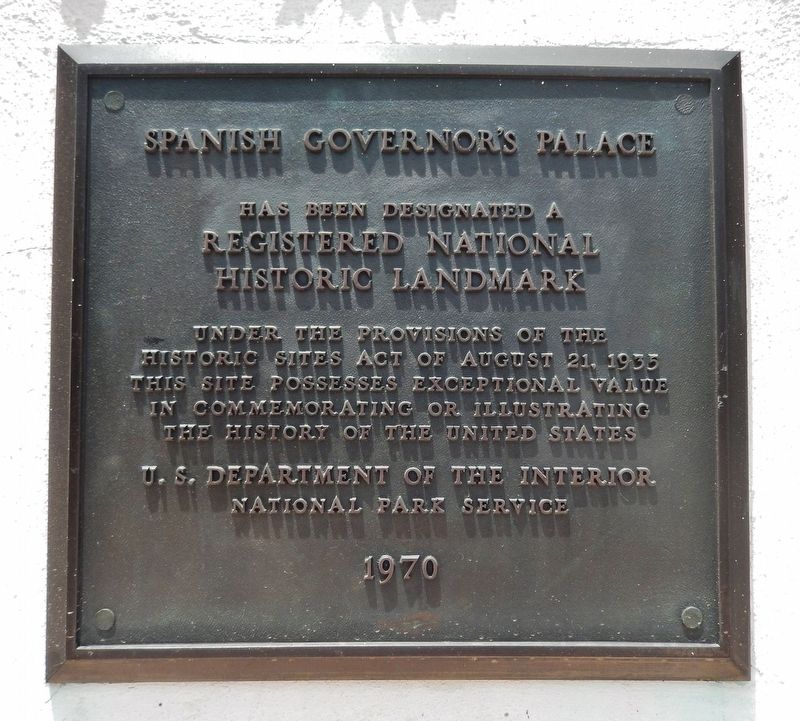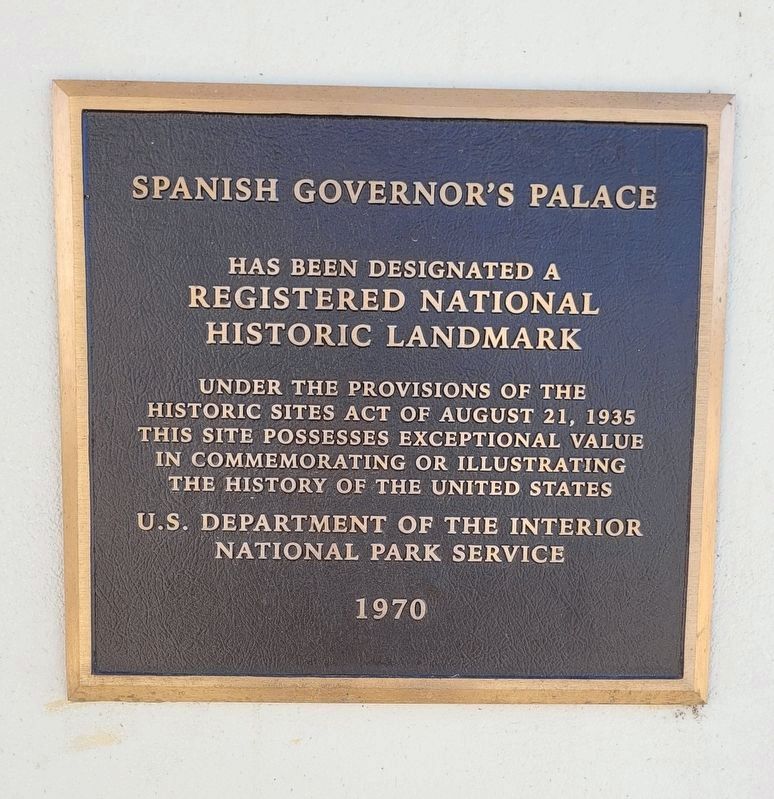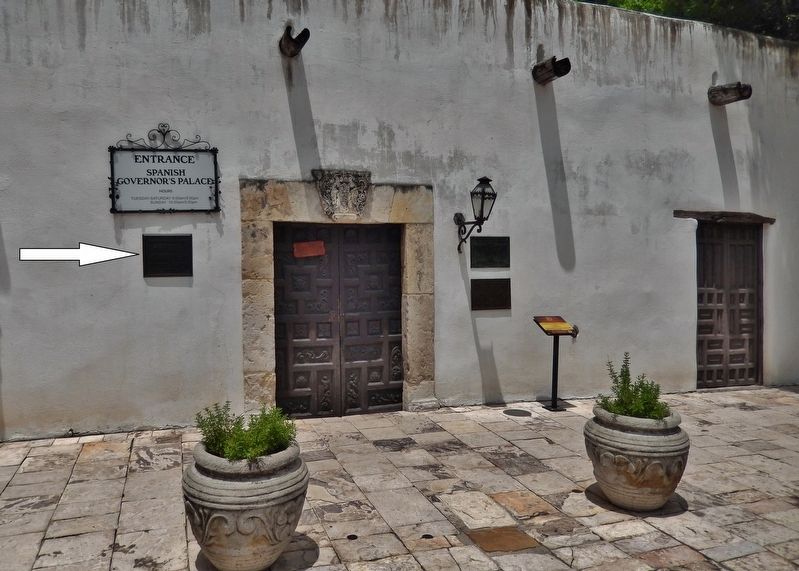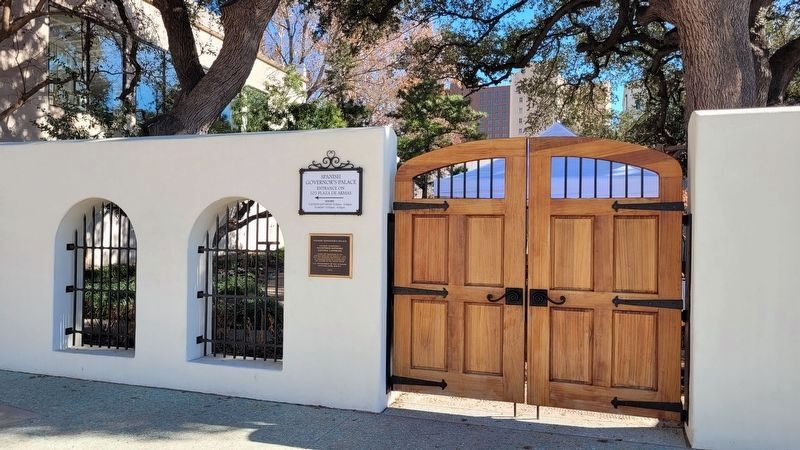Main/Military Plaza in San Antonio in Bexar County, Texas — The American South (West South Central)
Spanish Governor's Palace
Inscription.
Registered National
Historic Landmark
Under the provisions of the
Historic Sites Act of August 21, 1935
This site possesses exceptional value
in commemorating or illustrating
the history of The United States
U.S. Department of the Interior
National Park Service
1970
Erected 1970 by U.S. Department of the Interior, National Park Service.
Topics and series. This historical marker is listed in these topic lists: Colonial Era • Forts and Castles. In addition, it is included in the National Historic Landmarks series list.
Location. 29° 25.491′ N, 98° 29.744′ W. Marker is in San Antonio, Texas, in Bexar County. It is in Main/Military Plaza. Marker is on Plaza De Armas south of West Commerce Street, on the right when traveling south. Marker is mounted at eye-level, on the subject building, just left of the main entrance. Touch for map. Marker is at or near this postal address: 105 Plaza De Armas, San Antonio TX 78205, United States of America. Touch for directions.
Other nearby markers. At least 8 other markers are within walking distance of this marker. Moses Austin (within shouting distance of this marker); Growth of a City (within shouting distance of this marker); The Buried Past is Never Lost (within shouting distance of this marker); Plaza de Armas: Center of Commerce and Government (within shouting distance of this marker); Commerce Street (within shouting distance of this marker); The Mexican Revolution (within shouting distance of this marker); Barbed Wire (within shouting distance of this marker); Flood of the Century (within shouting distance of this marker). Touch for a list and map of all markers in San Antonio.
Regarding Spanish Governor's Palace.
The Spanish Governor’s Palace was constructed in the early 18th century and restored in the 1930s. This National Historic Landmark represents the last visual remnants of the Presidio San Antonio de Béjar. The Presidio was established as the result of a rivalry between Spain and France in the early 1700s for dominance of the territory that is now a part of the southwestern United States. To protect his claim against French encroachment, King Philip V of Spain ordered the governor of Coahuila and Texas, Don Martín de Alarcón, to build a mission and presidio at the headwaters of the San Antonio River and San Pedro Creek. On May 5, 1718, Alarcón established
the Presidio San Antonio de Béjar to protect the newly established Mission San Antonio de Valero (later known as the Alamo).
Related markers. Click here for a list of markers that are related to this marker. Presidio San Antonio de Béjar
Also see . . .
1. Spanish Governor's Palace / The Comandancia. Texas State Historical Association entry:
The Comandancia has stood on the west side of Plaza de Armas in the center of San Antonio, since the 1730s. At times the structure has been called the “Casa del Capitan,” indicating it was the residence of the captain of the San Antonio de Béxar Presidio, and in its more recent history, the “Spanish Governor’s Palace.” During the Comandancia’s first 200 years, seven generations of two prominent Tejano families owned the house. It is the only example of Spanish Colonial residential architecture remaining in Texas. (Submitted on June 3, 2018, by Cosmos Mariner of Cape Canaveral, Florida.)
2. Spanish Governor's Palace. National Parks Service entry:
Today, the only building that still stands of the Presidio San Antonio Bexar is the Spanish Governor’s Palace. It is one of the oldest residential buildings still standing in Texas. The building is a long one-story, U-shaped stone structure covered in stucco that surrounds a traditional Spanish patio and courtyard. The building was likely finished around 1749, the date given on the keystone above
the front entrance that bears the carved, double headed eagle from the coat-of-arms of Spanish King Ferdinand VI (or Hapsburg). (Submitted on June 3, 2018, by Cosmos Mariner of Cape Canaveral, Florida.)
3. Spanish Governor's Palace - San Antonio, Texas. Explore Southern History entry:
(This link presents interior and exterior photos of the Spanish Governor's Palace.)
Plans for the structure are known to have originated as early as 1722, when the Marquis de San Miguel de Aguayo proposed the construction of the palace in a letter to the King of Spain. The presidio or fort of San Antonio de Bejar was moved to the present site of the city that same year to protect the nearby mission of San Antonio de Valero (the Alamo). (Submitted on June 3, 2018, by Cosmos Mariner of Cape Canaveral, Florida.)
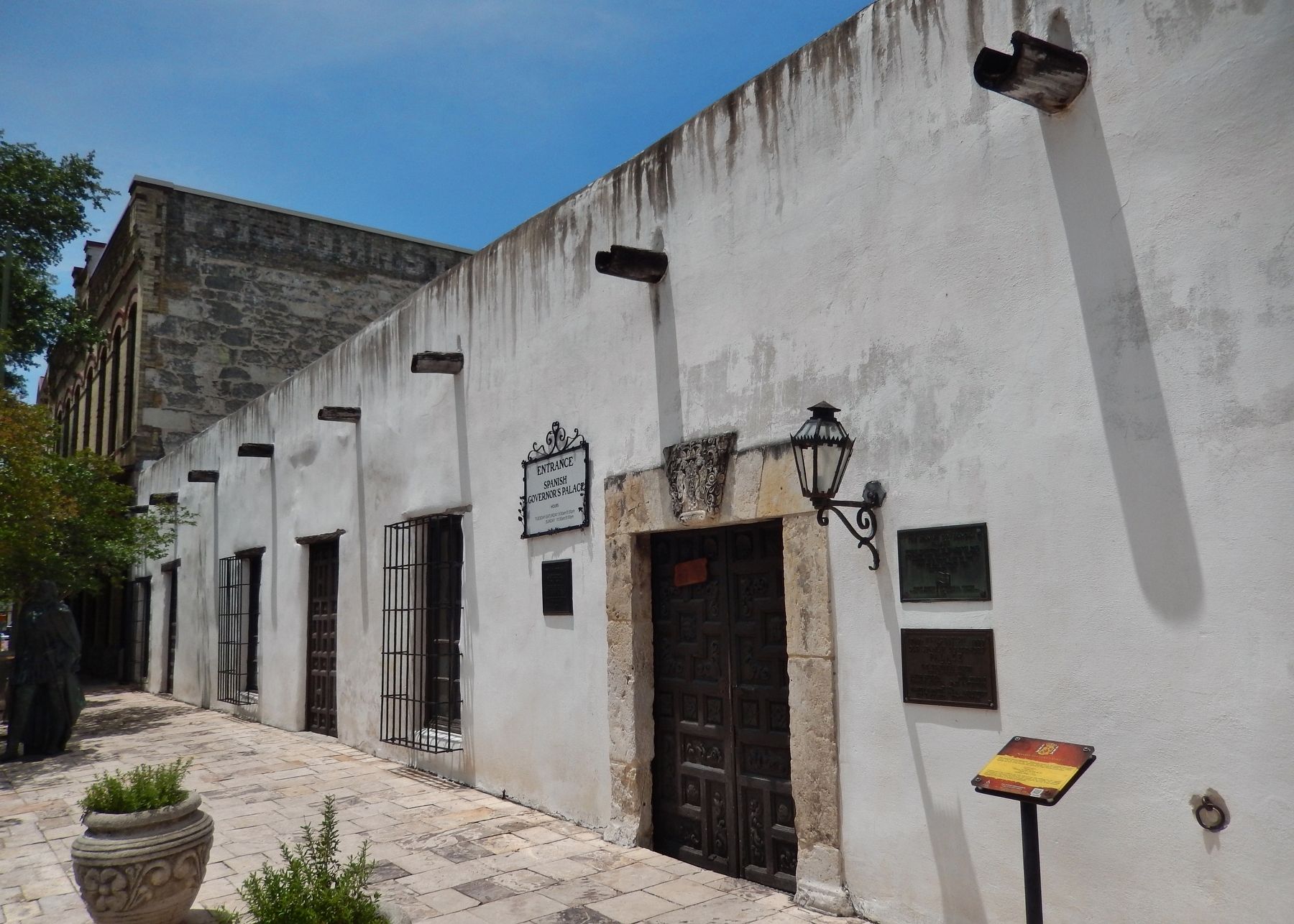
Photographed By Cosmos Mariner, May 21, 2018
5. Spanish Governor's Palace
Museum website homepage
Click for more information.
Click for more information.
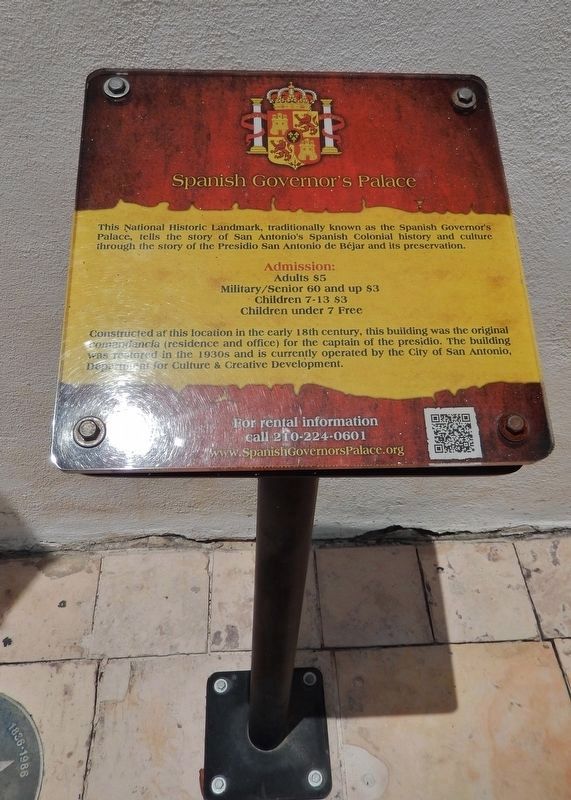
Photographed By Cosmos Mariner, May 21, 2018
6. Spanish Governor's Palace Sign
This National Historic Landmark, traditionally known as the Spanish Governor’s Palace, tells the story of San Antonio’s Spanish Colonial history and culture through the story of the Presidio San Antonio de Bejar and its preservation.
Constructed at this location in the early 18th century, this building was the original comandancia (residence and office) for the captain of the presidio. The building was restored in the 1930s and is currently operated by the City of San Antonio, Department for Culture and & Creative Development.
Constructed at this location in the early 18th century, this building was the original comandancia (residence and office) for the captain of the presidio. The building was restored in the 1930s and is currently operated by the City of San Antonio, Department for Culture and & Creative Development.
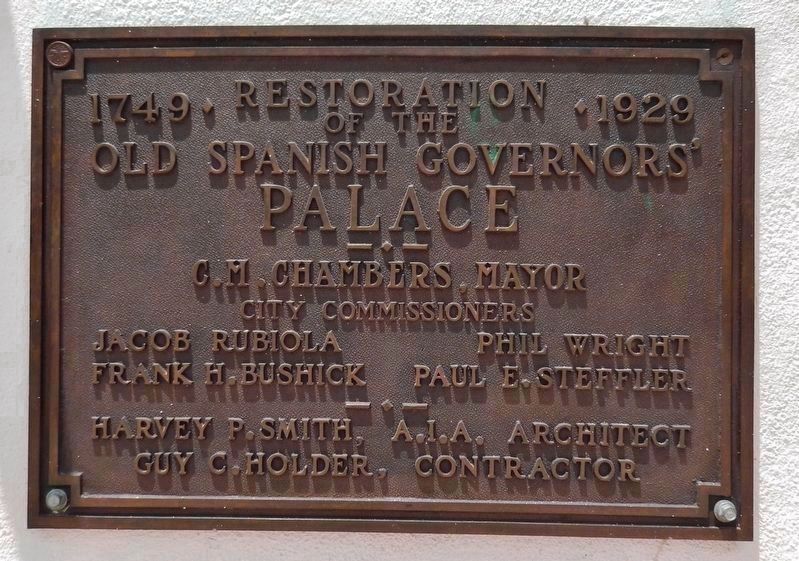
Photographed By Cosmos Mariner, May 21, 2018
7. Spanish Governor's Palace Restoration Marker (related marker mounted right of entrance)
1749 * Restoration of the *1929
Old Spanish Governors’
Palace
C.M. Chambers, Mayor
City Commissioners
Jacob Rubiola * Phil Wright
Frank H. Bushick * Paul E. Steffler
Harvey P. Smith, A.I.A. Architect
Guy C. Holder, Contractor
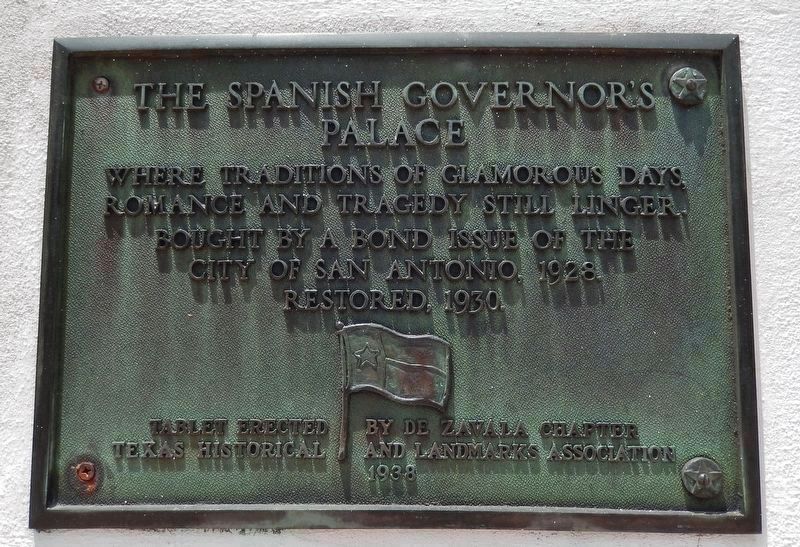
Photographed By Cosmos Mariner, May 21, 2018
8. Spanish Governor's Palace (related marker mounted right of entrance)
The Spanish Governor’s
Palace
Where traditions of glamorous days,
romance and tragedy still linger.
Bought by a bond issue of the
City of San Antonio, 1928.
Restored, 1930.
Tablet erected by De Zavala Chapter
Texas Historical and Landmarks Association
1938
Credits. This page was last revised on February 2, 2023. It was originally submitted on June 2, 2018, by Cosmos Mariner of Cape Canaveral, Florida. This page has been viewed 348 times since then and 15 times this year. Photos: 1. submitted on June 2, 2018, by Cosmos Mariner of Cape Canaveral, Florida. 2. submitted on January 21, 2023, by James Hulse of Medina, Texas. 3. submitted on June 3, 2018, by Cosmos Mariner of Cape Canaveral, Florida. 4. submitted on January 21, 2023, by James Hulse of Medina, Texas. 5, 6, 7, 8. submitted on June 3, 2018, by Cosmos Mariner of Cape Canaveral, Florida. • Andrew Ruppenstein was the editor who published this page.
